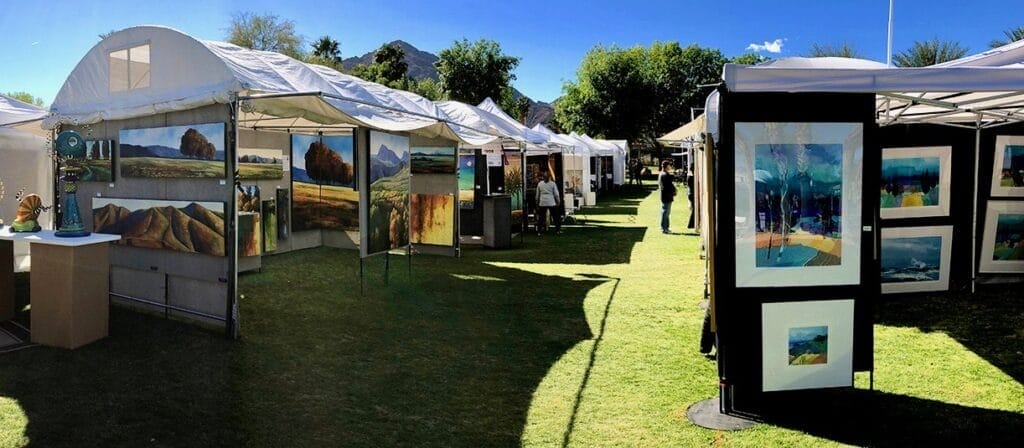
Creating an art booth that captivates attention, encourages interaction, and ultimately sells your artwork is a multifaceted task. It’s not just about the art itself, but also about the presentation, the atmosphere, and the artist’s readiness to engage with potential buyers.
This article provides a comprehensive list of essential items for setting up and running an art booth, ensuring your artwork is showcased to its maximum potential and your booth operation runs smoothly.
How to Set Up an Art Booth
Setting up an art booth requires careful planning and execution. Start by sketching a layout of your booth, taking into account the space’s dimensions and any physical constraints such as pillars or uneven ground.
Consider the flow of traffic and how visitors will move through your booth. Place your most eye-catching pieces where they’ll draw the most attention, such as at the front or center of your booth. Remember to leave enough space for yourself and your visitors to move around comfortably.
When it comes to the actual setup, it’s generally best to start with the larger elements and work your way down to the smaller details. Begin by setting up your display walls or panels and your backdrop, as these will form the structure of your booth.
Next, set up your tables and display stands, followed by your art hanging systems. Once these are in place, you can start hanging your artwork. Be sure to use a level to ensure your pieces are hung straight, and consider the viewer’s eye level when deciding where to place each piece.
Remember, the setup process can take longer than you expect, so give yourself plenty of time. It’s better to be slow and meticulous than to rush and make mistakes.
Read our in depth guide on Art Fair Excellence: Create a Winning Art Vendor Booth
Booth Setup and Display Equipment
Display Walls: Display walls are the foundation of your booth design. They offer a clean, neutral background that allows your artwork to be the star of the show. Brands like Pro Panels are reliable and offer a range of sizes and finishes to match any style or theme.

Backdrop: A professional backdrop can enhance your booth’s aesthetic and make your artwork pop. Whether it’s a simple fabric or a custom-printed design, ensure it complements your artwork without distracting from it.
Display Stands and Tables: Display stands and tables bring structure to your booth, enabling you to showcase smaller artworks or prints at an optimal viewing height. Don’t forget a tablecloth to add a polished look and hide any storage underneath.
Art Hanging Systems: Art hanging systems ensure your artwork is safely and evenly displayed. They also provide flexibility, enabling you to effortlessly modify your display as required. Walker Display offers a variety of hanging systems, from simple hook and rod systems to more sophisticated options.
Booth Lighting: Effective lighting is crucial when it comes to highlighting your artwork. Battery-powered LED lights, such as the LUXSWAY Wireless Picture Light, are a versatile option. They provide warm, adjustable light that emphasizes the textures and hues in your work without requiring an electrical outlet.
Artwork Bins and Portfolio Books: Artwork bins and portfolio books are excellent ways to display additional pieces or examples of commissioned works without overcrowding your booth. Consider the durable and stylish Canvas Print Bins from Jerry’s Artarama and the Itoya Art Profolio with clear, high-quality pages that safeguard your art while keeping it easily viewable.
Booth Signage: Never underestimate the power of clear signage. A professional sign featuring your name, logo, or booth number makes your space easily recognizable.
Booth Operations Items
Business Cards and Promotional Items: Business cards provide a tangible reminder of your art and your contact information. In addition to business cards, consider other promotional items like stickers, magnets, or pins that feature your art.
Payment Processing Equipment: In today’s digital age, having a card reader or mobile payment system is crucial. Many customers prefer cashless payments, so having a system like Square or PayPal can make transactions smoother.
Emergency Kit: An emergency kit is always good to have on hand. It should include items like a first aid kit, extra price tags, pens, tape, scissors, and any other items you might need in a pinch.
Refreshments: Having water and snacks on hand is important, especially during long shows. They’ll keep you hydrated and energized throughout the day.
Packaging Materials: Have packaging materials ready for sold items. This can include bags, boxes, bubble wrap, or tissue paper. It not only protects your art but also provides a professional touch to your sales.
Personal Items: Remember to pack personal items like sunscreen, a hat, or a jacket, depending on the weather. If the event is outdoors, you might also want to consider insect repellent.
Cleaning Supplies: Bring some cleaning supplies to keep your booth tidy throughout the event. This could include a small broom and dustpan, paper towels, and trash bags.
Extension Cords and Batteries: If you’re using electronic equipment, such as lights or a digital payment system, it’s a good idea to bring extra extension cords and batteries.
Sales Record Book or Digital App: Keeping track of your sales is important for inventory management and accounting purposes. A simple notebook can work, or you could use a digital app designed for this purpose.
Wi-Fi Hotspot: If the event doesn’t provide reliable Wi-Fi and you’ll be processing digital payments or need internet access for any other reason, consider bringing a portable Wi-Fi hotspot.
Spare Change: If you’re accepting cash payments, it’s important to have a cash box with plenty of spare change.
Final Tips for your Art Booth
While the items and equipment mentioned here can undoubtedly enhance your art display, the most critical element in your booth’s success is the artwork itself. Invest in high-quality tools, but remember to continually refine your craft and nurture your unique artistic style.
The key to a successful art booth is not just the artwork itself, but also the overall presentation and your preparedness. These practical items will ensure you’re ready for any situation and can focus on showcasing your art and engaging with potential buyers.
And finally, don’t forget to step back and look at your booth from a visitor’s perspective. Make sure everything is inviting, accessible, and showcases your art in the best possible light.






